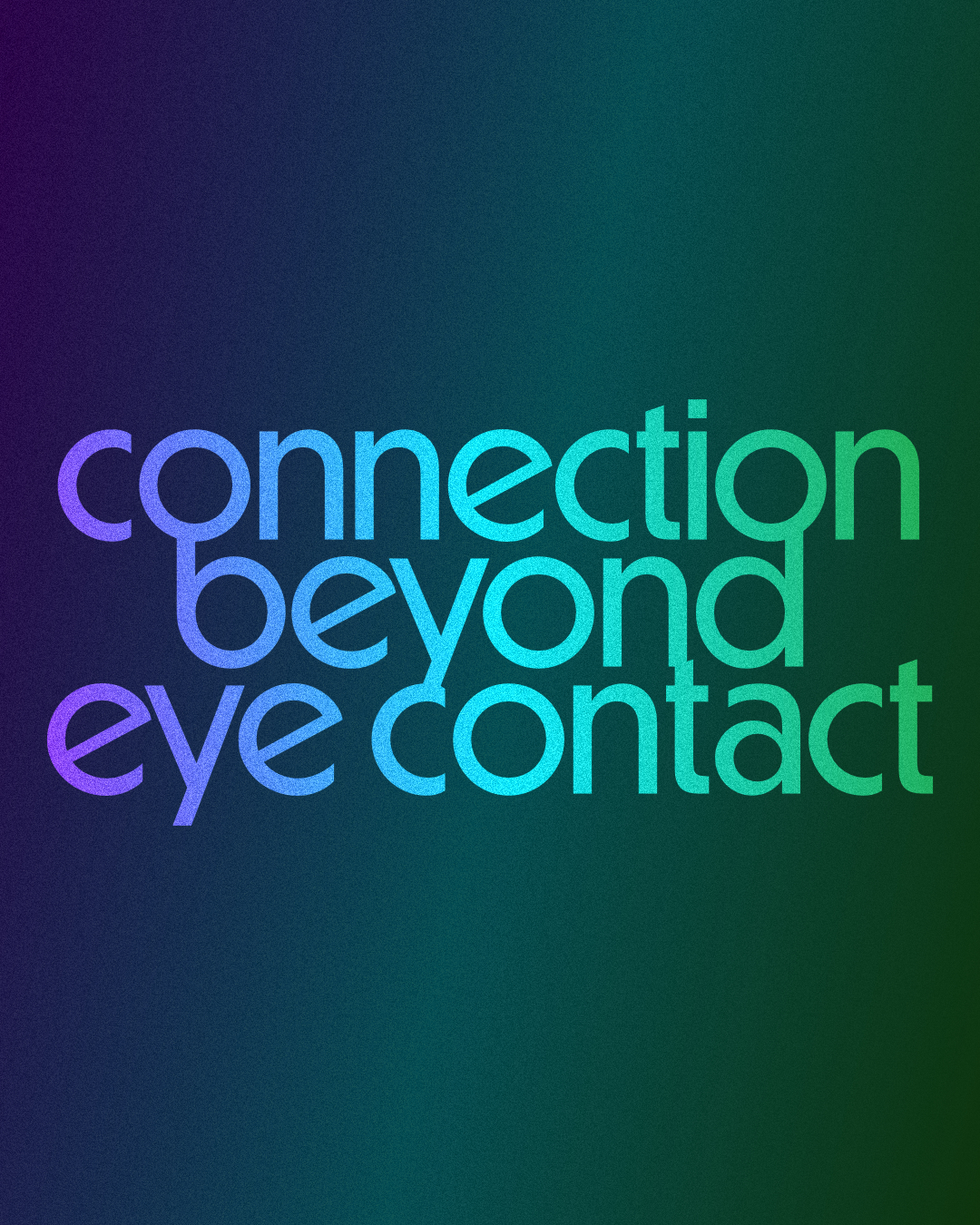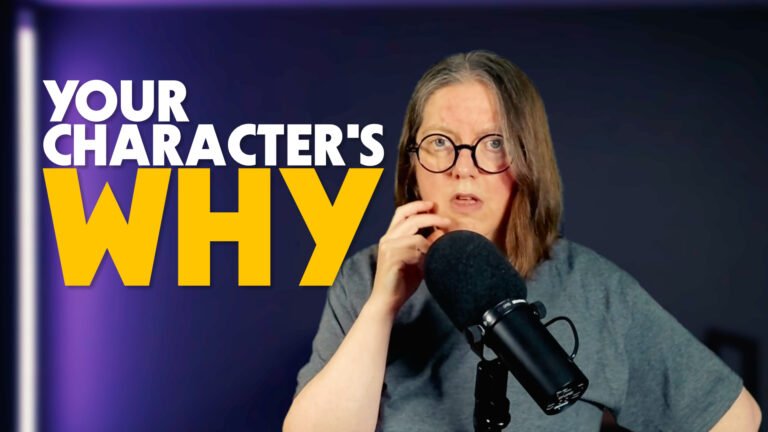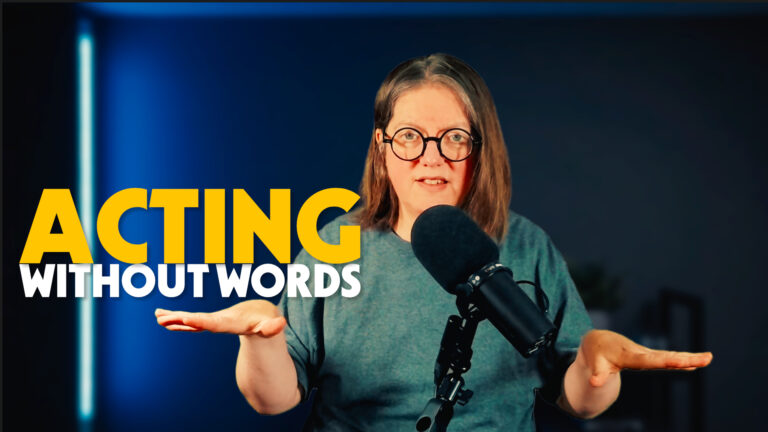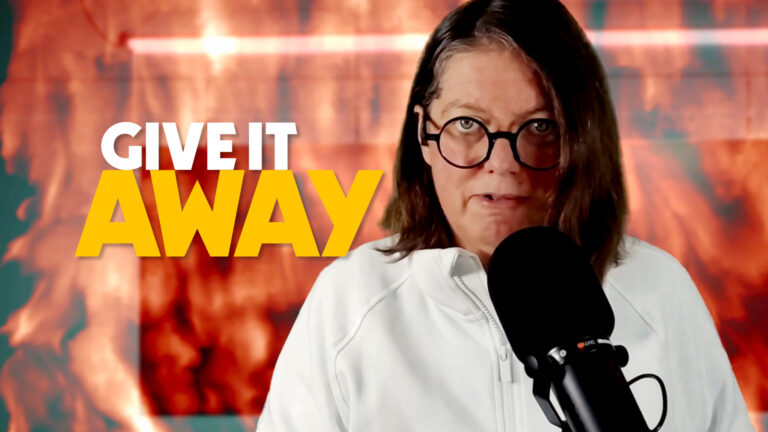
This article is about making eye contact with your scene partners, and other ways that improvisers and actors can facilitate connections on stage if meeting a direct gaze is not available to you. Traditional modes of connection are sometimes not available for neurodivergent humans who take part in most of your teams and classes.
But know what? Improv is flexible, so if eye-to-eye makes you uncomfortable we have several other options on deck to connect. Keep reading to learn about some of them. Nice!
Eye contact, focus, connection
Looking your scene partner in the eye is one way to connect with them in a scene, and of course is an effective way to do so. But for some of us, a direct eye gaze presents a real challenge. We can even measure that difficulty scientifically. And science knows a lot about it (find some links to literature in the next section).
The challenge of eye contact for some
Difficulty or challenges with eye contact exists for some improvisers and actors. This challenge comes from cognitive wiring (such as a neurotype like autism or ADHD), trauma, lived experience, culture, or anxiety. And it isn’t minor either – we’re not talking about an easy adjustment, something to “just learn”, or breaking a “habit”. This isn’t just a preference, it’s painful for some people and an automatic, wired-in response.
For some humans, there is confusion about what gaze is “appropriate” – the socially dominant way gaze is held isn’t instinctual. You might not have an automatic instinctual response for how and when to look at the person you’re talking to (there is apparently a “socially dominant” ratio of how much you meet a direct gaze and avert your eyes).
So, you might try to figure out the acceptable duration of looking at someone in the eyes vs. diverting the gaze. Basically, what interval and duration to do each thing with another human being.
Or, maybe you don’t even notice that your instinct is not the same as the socially dominant instinct in your culture.
Some of you might be able to learn how to adjust to the socially dominant eye gaze ratio, as the adjustment isn’t too stressful or painful to adopt. But, adopting a non-instinctual eye gaze ratio is a manual process that might take up energy that can be better used for other things. Like reading other social cues, perhaps. It depends on the individual.
Some of you might feel an intense overwhelm meeting someone’s gaze. Meeting that direct gaze can feel incredibly uncomfortable because it overactivates certain parts of their brain. This overwhealm is even proven with medical imaging.
Or eye gaze might just be confusing and cause people to overthink their gaze, experience anxiety about it, and so on. Or your experience might be somewhere in between these all these things, or something else entirely.
Essentially, neurons activated during direct eye-to-eye contact are different between human brains. So, if you heard, advised, or have been told that you should “do some eye contact” or otherwise change it to better connect or communicate with a scene partner – reactions to that advice, or what you actually need to adjust, can vary.
You don’t have a problem with eye contact
Great! But you will probably be at an advantage to understand what’s going on with your scene partners or students. And you should probably continue reading this anyway.
It’s important to be aware that some of your students and/or scene partners can feel overwhelmed with direct eye contact, or just with the idea of direct eye contact. They might handle gaze differently. They might not even realize their gaze doesn’t follow “socially dominant” gaze conventions. Or whatever.
So – you will have to adapt to a scene partner who isn’t connecting with direct eye contact at some point. You will need to meet in the middle and find other ways to connect along with them.
Also, because eye contact is only one social cue and mode of communication, it’s always good to incorporate others. And remember that these cues can be handled and understood in different ways. If something doesn’t make sense on either side of the scene, listen and communicate to figure it out – use alternative tools.
You can connect in alternative ways
You won’t fail improv if you prefer to not get in your head about eye contact. There are other ways to connect, listen, react. There are alternatives to do the scene without staring at someone eye-to-eye or doing the socially dominant “flavor” of direct gaze.
After all, we manage to connect outside of scenes. Figure out what that is, it’s an option to do it that way – whatever that is for you.
So if you are getting/giving the note, or direction, to “use eye contact to connect” – adjust that idea to how reading people works best for you (“whatever that means to you” as we often like to say I guess).
After all, the purpose is to connect to and read your scene partner.
Here are some alternatives you can try or discuss with a trusted coach, teacher, or director. Try these, adjust, or analyze how you do this with other humans outside of the scene and try that on stage.
Break the gaze when you want, in whatever ratio is comfortable for you.
It’s fine to avert your eyes from a direct gaze when you want, and return to direct eye contact if and when you’re comfortable. Perhaps you don’t meet a gaze as often as you, or someone else, would ideally like. That’s fine. Your ratio might not be the socially dominant eye gaze ratio… but that’s okay.
And if eye gaze is no problem for you, remember that it might be uncomfortable for your scene partner (or… their character!)
Improv and acting doesn’t need to be uncomfortable (it can be, if you want it to of course… but it doesn’t gotta be!) There are other ways to connect and do the scene. This kind of diversity in characterization also helps represent the vast diversity of humans, which ultimately makes scenes more relatable.
Also, if this eye gaze experience is real to you, it can be real for your character too.
Soften or avert your gaze entirely.
Don’t look directly in the eyes, but soften your gaze and just take in the gist. Assess the body language, look at the chin, assess the vocal tone your scene partner uses. You can listen to the words they say. You can ask questions, too – even in improv, as your character (not asking questions is mostly a teaching tool, early on).
Is there something you actually do outside of scenes to make a connection? Try that as your character.
Outside of the scene, think about how you really connect with people, and your character can do that too in order to connect to the scene. Adopt that tool on stage.
Use verbals to connect with honesty
If you’re ever confused, or you’re having a challenge connecting:
- Ask in character
- Tell them what you think
- See if you’re right or wrong
What would you want to do if this was happening outside of a scene? Responding honestly usually works.
Don’t worry about social graces if you’re inside of a scene, as your character – we might not ask some of these things in real life, we might not blurt out our innermost feelings, but it’s much more acceptable in the scene. Which is why improvising can feel pretty freeing for your neurodivergent mind.
Remember, it’s realistic enough if your response is something you’d genuinely want to do or ask, unmasked, as YOU. So go with honesty if you’re in doubt or ever feel uncomfortable. Again… that’s why this craft can end up feeling freeing to you!
Humans are designed to connect in many different ways. Emotions are handled in very different ways between neurotypes. We can use and capitalize upon that variety, our diversity, in improv.
This isn’t an exhaustive list. So let’s discuss this article!
This is not a comprehensive list for you. Just a few ideas of what to start off with, or to get you thinking of your own situation.
Do you have suggestions for other ways to connect? There is so much variety amongst neurotypes and even within the same one! Your input is helpful and valued.
These articles are not delivered on a web page. Discuss this article in the Improv Update discord community. There is a forum specifically for this newsletter, and a pinned entry for this post on connection. Add your tips, thoughts, and/or questions!
Join us here: Forum discussion in Discord




